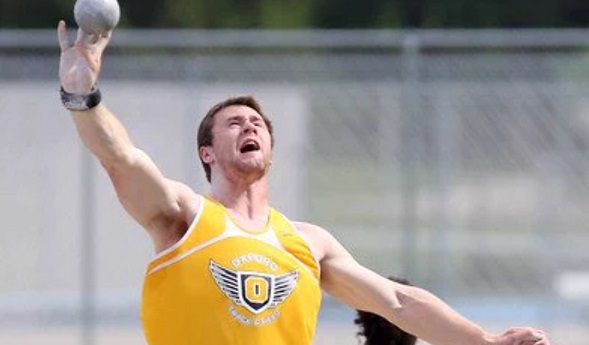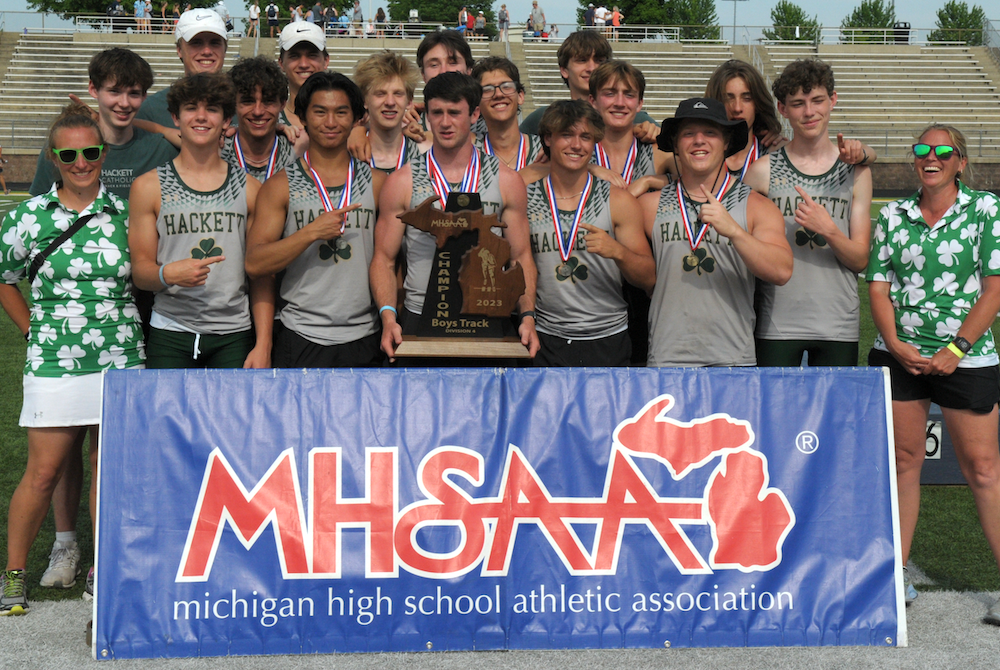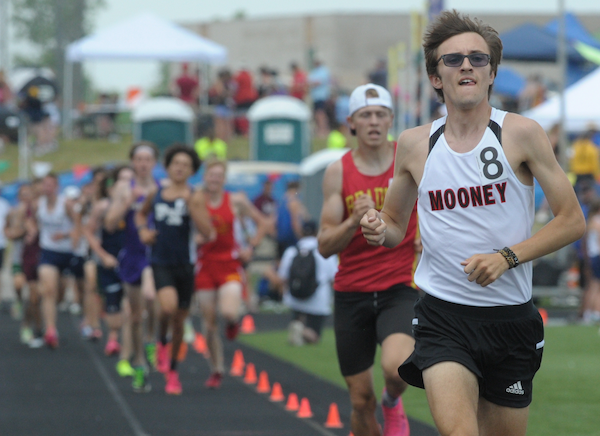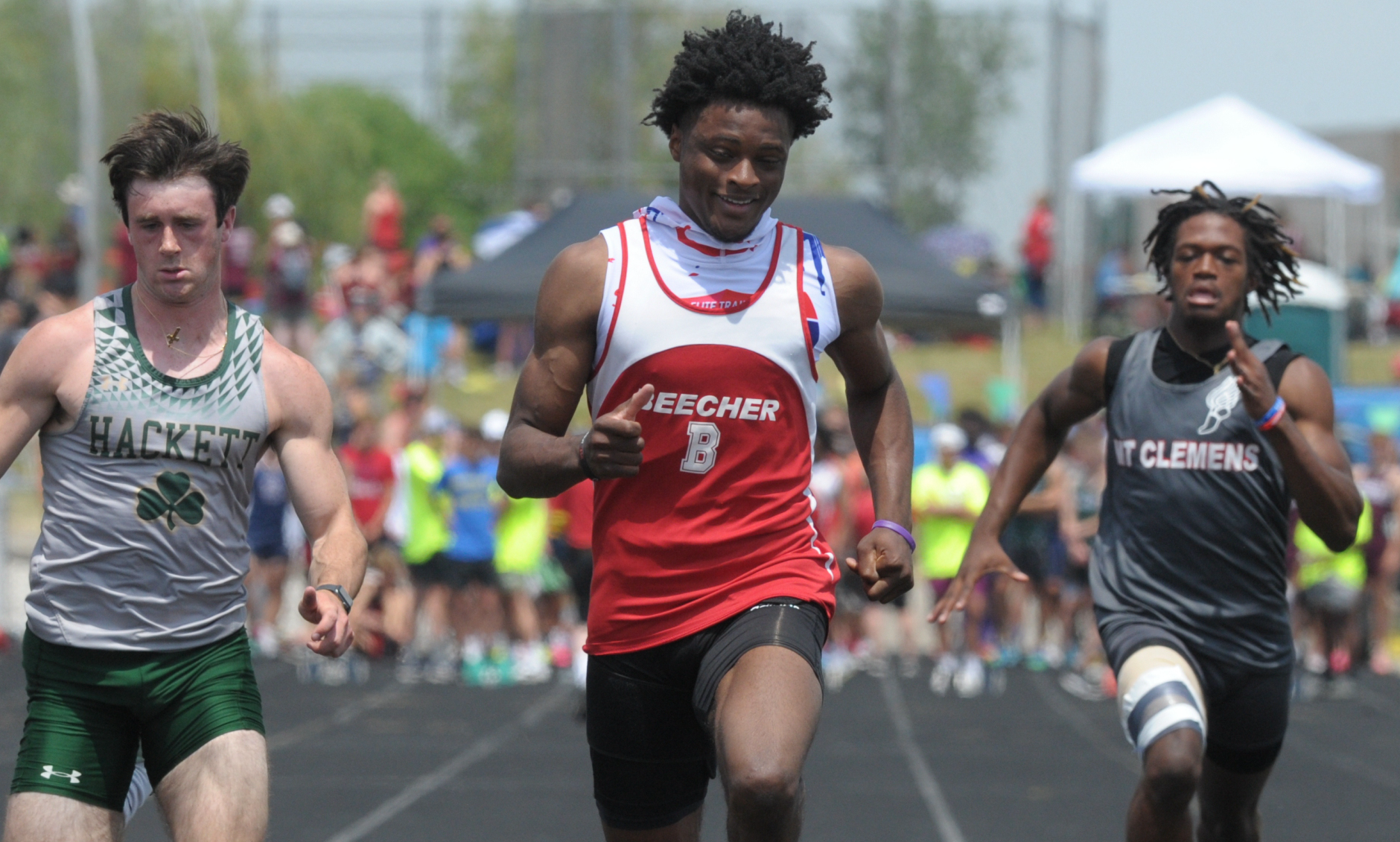
Performance: Oxford's Connor Bandel
June 1, 2016
 Connor Bandel
Connor Bandel
Oxford senior – Track & Field
Bandel could’ve been a selection most weeks this season; the spring has included that many highlights for the reigning Lower Peninsula Division 1 champion in shot put and discus. He was perhaps most dominant at his Regional on May 20 at Lake Orion, winning shot put by 16 feet with a toss of 63, 7 inches, and discus by nearly 28 feet at 189-2 to earn the Michigan National Guard Performance of the Week for May 16-22.
Bandel went on to win the Oakland County Championship titles Friday in both at 67-2½ and 192-0, respectively, and his top throws this spring are that shot put and a discus toss of 204-2 on April 23 at the Oxford Invitational. He will compete in the LP Division 1 Finals this weekend with opportunities to break the all-Finals records in shot put (Todd Duckett, Kalamazoo Loy Norrix, 64-0½, 1999) and discus (Cullen Prena, Walled Lake Central, 210-1, 2012). Prena is among those Bandel has consulted for advice as he’s improved significantly over the last few seasons; his top throws in 2016 are six feet better in shot put and 11 in discus from a year ago.
 The 6-foot-4, 230-pound senior also played goalkeeper for Oxford’s varsity soccer team the last four seasons and will be the second sibling from his family to play at the Division I college level; he’s signed for track & field with the University of Florida, while his older sister Darien plays volleyball at Oakland University. Connor also played basketball as a freshman and carries a 3.3 grade-point average; he’s considering majoring in chemical or biomedical engineering.
The 6-foot-4, 230-pound senior also played goalkeeper for Oxford’s varsity soccer team the last four seasons and will be the second sibling from his family to play at the Division I college level; he’s signed for track & field with the University of Florida, while his older sister Darien plays volleyball at Oakland University. Connor also played basketball as a freshman and carries a 3.3 grade-point average; he’s considering majoring in chemical or biomedical engineering.
Coach Matt Johnson said: “The number one thing Connor brings is (his example) that track and field is a year-round event, from conditioning to weight training to building camaraderie with his teammates around the track. … He’s a dedicated athlete, he sets goals for himself, and that would be a value set that I’d say could be passed on to another level of student. He’s not just setting benchmarks for things within reach; he’s setting dreams he’s going to work toward. Early on last year, he told me he’s aiming not for the state record, he’s aiming to become an international competitor, and that raises the bar right there. Most high school kids are not even thinking (about that) at that point.”
Performance Point: “I’m trying to improve every meet; that’s always the goal. But this past week I started to improve more. I’m constantly moving the benchmark forward a bit. … Sometimes I just can’t really explain how much emotions I'm feeling when something (like a personal record) just happened. When you PR something that you’ve never reached, it’s just so satisfying to actually do that.”
Expert advice: “The biggest thing with (my sister) was her type of dedication and trying to do the same thing as her. Another big thing was the recruiting process; it was nice to have a sibling because not only did I get to learn from her but my parents got to learn a lot from her about the questions to ask coaches and that kind of deal. (From Prena), I learned definitely technique from him; it’s nice to have him having worked with his college coach, because … then he could teach me a lot of what he had learned. I always ask him about summer track, nationals and international competition. Even though he hasn’t gone to an international competition, he went to meet qualifiers for those, and if I have questions about what the atmosphere is like, things like what I need to bring, he’s always a good resource.”
The mental game: “For me, it’s not to get really tense. If I get really tense, really focus on trying to throw as far as I can, I’m not going to throw as well. The more relaxed you are, the longer you’ll be, the more comfortable you’ll be. Not getting tight and seized up and that sort of deal, that’s the biggest thing to me, to really relax … and trust what I’ve been doing the last couple of years, be comfortable and have fun with it. If you have a smile on your face, you’ll probably throw farther … (and) I’m just trying to throw farther than I did before.”
 Final countdown: “I’d definitely, now that I’ve won (in 2015), I would like to re-break the shot put record, and I would like to break the discus record for the first time. I really want to hit my goals; I wrote them down before the season, and I’m still on pace. I feel like breaking 79 (feet in shot put) and 215 (in discus) before the season is over, that would be absolutely fantastic.”
Final countdown: “I’d definitely, now that I’ve won (in 2015), I would like to re-break the shot put record, and I would like to break the discus record for the first time. I really want to hit my goals; I wrote them down before the season, and I’m still on pace. I feel like breaking 79 (feet in shot put) and 215 (in discus) before the season is over, that would be absolutely fantastic.”
Create and explore: “I’ve always really been into math and science, always really liked the engineering aspects of creating and exploring new ideas. I thought with how much petroleum that the United State is using, and with how many athletes have injuries, I thought it would be cool to create new ways to produce energy, or for athletes the fastest ways to recover.”
– Geoff Kimmerly, Second Half editor
Every week during the 2015-16 school year, Second Half and the Michigan National Guard will recognize a “Performance of the Week" from among the MHSAA's 750 member high schools.
The Michigan Army National Guard provides trained and ready forces in support of the National Military Strategy, and responds as needed to state, local, and regional emergencies to ensure peace, order, and public safety. The Guard adds value to our communities through continuous interaction. National Guard soldiers are part of the local community. Guardsmen typically train one weekend per month and two weeks in the summer. This training maintains readiness when needed, be it either to defend our nation's freedom, or protecting lives and property of Michigan citizens during a local natural disaster.
Previous 2015-16 honorees
May 18: Kalyn Breckenridge, Birch Run girls soccer - Read
May 11: Morgan Beadlescomb, Algonac boys track & field - Read
May 4: Abby Krzywiecki, Farmington Hills Mercy softball - Read
April 27: Mike Mokma, Holland Christian baseball - Read
April 20: Abby Divozzo, Cadillac girls soccer - Read
March 30: Cassius Winston, Detroit U-D Jesuit boys basketball - Read
March 23: Kierra Fletcher, Warren Cousino girls basketball - Read
March 16: Jacob Montague, Grosse Pointe South swimming & diving - Read
March 9: Kyle Tuttle, St. Charles boys bowling - Read
March 2: Brittney Schnicke, Caledonia girls bowling - Read
Feb. 24: Kamari Newman, Detroit East English boys basketball - Read
Feb. 17: Jason Whitens, Powers North Central boys basketball - Read
Feb. 10: Rachel Hogan, Grand Ledge gymnastics - Read
Feb. 3: Nehemiah Mork, Midland Dow swimming & diving - Read
Jan. 27: Mardrekia Cook, Muskegon girls basketball - Read
Jan. 20: Sage Castillo, Hartland wrestling - Read
Jan. 13: Rob Zofchak, Dexter swimming & diving - Read
Jan. 6: Tyler Deming, Caro wrestling – Read
Dec. 15: Jordan Weber, East Jordan boys basketball – Read
Dec. 8: Kaitlyn Geers, Kent City girls basketball – Read
PHOTOS: (Top) Oxford's Connor Bandel unloads a shot put during a meet this season. (Middle) Bandel is the reigning champion in both the discus and shot put in Lower Peninsula Division 1. (Photos courtesy of Connor Bandel.)

Thrower Claims Lone Individual Title to Lead Hackett to Team 3-Peat
By
Tom Lang
Special for MHSAA.com
June 3, 2023
Kalamazoo Hackett Catholic Prep just keeps winning and winning.
This time the Irish took home their fourth title in the last five Lower Peninsula Division 4 Track & Field Finals, on Saturday at Hudsonville.
Hackett’s only individual title was taken by discus winner Nathan Buchmann, a senior, who was fine knowing he was the shortest in stature among all the sizable competitors.
“In the offseason after football I worked out every day, working towards this goal,” he said after getting his medal. “I would say this takes 80 percent technique and 20 percent strength to throw the discus. So, length can help but if you have good technique and are really strong, that will play into it.
“I think we are very balanced throughout the meet today,” he said about teammates that scored points in finishes other than first place. “We have 13 guys here today, and we have people in a lot of the races. But I do not run; I have too short of legs to be a fast runner,” he said with a chuckle.
Buchmann had to work through a hip injury to compete this spring.
“I think the setbacks are what make you strong,” he said. “You can either give up through the setbacks or push forward and become better.”
 Coach Charissa Dean agreed.
Coach Charissa Dean agreed.
“The kids have big hearts,” she said after all the points were totaled and the Irish were on top once again, with 53. “They worked hard. They had a lot of potential when we started the season. And we had a lot of drive to put in the work, and we are happy the results came out the way they did.”
Reading was runner-up at 47 points, followed by Wyoming Potter’s House Christian with 42, then Fowler and Flint Beecher each with 37 points.
Senior Lezawe “Moses” Osterink, of Potter’s House Christian, placed second in 1,600 but took the 3,200 title as defending champ of both. He dominated the latter by lapping the field with a final lap kick that resembled more of a superhero speedster.
“Nobody really took it out that hard at the start,” he said. “There was a freshman (Marek Butkiewicz of Hackett) that tried to get the pace going quick, but me and Dakota (Dykhuis of Montabella) just kind of sat back and gradually pulled him through.
“We took it gradually, and I was just relying that I could kick.”
Kick did he ever. The trio were neck and neck the majority of the race in a grouping ahead of the pack.
“With 400 to go I just tried to go all out,” Osterink said. “I had a lot more left than I thought and I was pleased with the win. Not really the time, but that doesn’t matter, especially this hot out.”
The overall meet was in the low 90s/high 80s heat and searing sun all day. So, race officials allowed the unique opportunity for coaches to spray the runners with water and give them water bottles.
“It was very weird because I’ve never taken water to drink while I’m running, so I didn’t know how that would feel,” Osterink said. “And they were spraying us and hitting us in the face. It was kind of fun.”
Junior Tyler Lenn of Marine City Cardinal Mooney defeated Osterink at his own game in the 1,600.
“I’m feeling great,” Lenn said after grabbing the medal. “I said to a newspaper after one of my races (during the season) I was right where I wanted to be. This has been a long rebuilding process for me since an injury back in the fall, and I set a pretty high goal the day the injury happened. I was telling myself I needed to fulfill what I said I would do at the beginning of last cross country season. And that is what I did today.”
Lenn suffered an ankle sprain from a misstep that turned worse because he kept running through the season on it.
“Coming back from that was pretty tough, but I wouldn’t have it any other way,” he said.  “Perseverance; I said from the beginning what I was going to do. I kept my eye on that target, and no matter the circumstances life threw at me, that I was going to make it happen and I am a man of my word.”
“Perseverance; I said from the beginning what I was going to do. I kept my eye on that target, and no matter the circumstances life threw at me, that I was going to make it happen and I am a man of my word.”
Jaylin Townsend, a senior from Flint Beecher, dominated the short races. He won the 100 dash (10.67) and 200 dash at 22 seconds flat. It was his third 100 win at a Finals.
“I put in a lot of work; I had to three-peat,” he said after the 100. “There’s a lot of great competition here, so I knew I had to come out and run my best.”
Concord in the 400 (43.72), Buckley in the 800 (1:30.76) and 1,600 (3:29.13) and Potter’s House in the 3,200 (8:14.18) were relay champs Saturday. Reading’s Tayshawn Bester won the 110 hurdles (15.13), and Athens’ Landen Bennett won the 300 (39.85). Caseville’s Nathan Feltner won the 400 (50.76), and Vestaburg’s Owen Patton claimed the 800 (1:55.11).
Fruitport Calvary Christian’s Bradley Richards won the high jump (6-10), and Peck’s Alex Affer won the long jump (23-4). McBain Northern Michigan Christian’s Isaac Bowden was first in pole vault (13-0), and Brown City’s Kyle Affer won shot put (49-2).
PHOTOS (Top) Kalamazoo Hackett Catholic Prep celebrates its third-straight LPD4 title Saturday. (Middle) Cardinal Mooney's Tyler Lenn, far right, sets the pace in the 1,600. (Below) Flint Beecher's Jaylin Townsend, middle, crosses the finish first for one of his two sprint championships. (Photos by Ken Swart/RunMichigan.com.)

